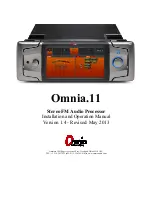
www.ti.com
22
CapTIvate™ Touch Getting Started Manual
Copyright © 2020, Texas Instruments Incorporated
Figure 5-4 MCU status in Wake-on-Prox mode
5.1.3
The
relationship of important parameters in CapTIvate™
Figure 5-
5 Schematic diagram of parameter relationships in CapTIvate™
The parameter structure in the entire CapTIvate™ is shown in Figure 5
-5. The whole is divided into hardware
configuration parameters and software configuration parameters, all of which are configured in the sensor widget.
From this, you can also know which parameters can be automatically updated when the CPU is not working and
the CapTIvate™ MCU is in Wake
-on-Prox mode.
First, the sampling module generates raw data by detecting the external capacitance. Conversion Count and
Conversion Gain determine the gain of the sampling module. Then the data passes through the optional anti-noise
module (sampling frequency spread spectrum, oversampling and other functions) to achieve noise filtering. It
should be noted that for GEN1, part of the anti-noise function will be implemented by software.
The output data will first be judged by Error Threshold. Then filterCount (default intensity 1) is generated through
IIR filtering of different intensities, which is used to characterize real-time capacitance changes, and LTA (Long time
average, default intensity 7) is used to characterize the base capacitance of the environment. Here filterCount
corresponds to "Count" in the GUI data monitoring module, and LTA corresponds to "LTA". The Delta between the
two is used to characterize the change of capacitance generated by human hand touch. The relationship between
the capacitance change caused by the touch and the filterCount and LTA is shown in Equation 5-3. For self-
capacitance detection, Delta is a positive value, and for mutual-capacitance detection, Delta is a negative value.
𝐷𝑒𝑙𝑡𝑎 = filterCount − LTA
(5-1)
𝐶 = 𝛼 ∗
Gain
filterCount
(5-2)
∆𝐶
𝑡𝑜𝑢𝑐ℎ
= 𝐶
𝑡𝑜𝑢𝑐ℎ
− 𝐶
𝑏𝑎𝑠𝑒
= 𝛼 ∗ Gain|
1
LTA + Delta
−
1
LTA
|
(5-3)
The entire signal change process is: when power is on, the calibration function will calibrate the equivalent value of
the environmental base capacitance to Conversion Count. That is, LTA = Conversion Count. Therefore, Conversion
Count can also be understood as a parameter that determines the resolution of the system. At this time, because
there is no touch, filterCount=LTA. When touched by a human hand, due to the different filter strengths of the LTA
Filter and the Counter Filter, the filterCount will change rapidly, and the Delta will increase from 0. When the Prox
Threshold is triggered, the LTA Filter will be closed and the LTA value will remain unchanged. FilterCount continues
to change, Delta continues to increase, which triggers Touch Threshold. When the hand leaves, if the signal is
weaker than the Prox Threshold, the LTA Filter opens and the LTA value starts to refresh. Therefore, the Prox
Threshold must be smaller than the Touch Threshold to ensure the normal working mechanism of LTA. In addition,
if the Prox Threshold is set too large, human touch will cause the LTA to change significantly, and the LTA will drift
after multiple consecutive touches, and the system cannot correctly respond to subsequent touches.
Strictly speaking, both Prox Threshold and Touch Threshold are thresholds set for Delta. When triggered, the
corresponding global variable of the system is set, and the signal will be sent to the subsequent program logic. It
should be noted that Prox Threshold is an absolute threshold, while Touch Threshold is a relative threshold. The















































